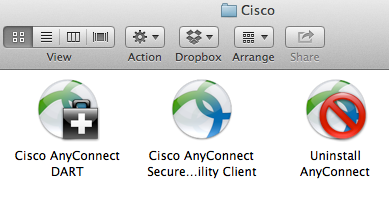Download the Mac OS X Cisco AnyConnect client from My.queensu.ca. Go to the software tab; Locate the downloaded DMG file and double click to open it Double click the AnyConnect.pkg icon to start the Installation The Install AnyConnect Secure Mobility Client screen will open. Click the Continue button; The Software License Agreement screen will open. Read the License agreement. Answer Yes when prompted to remove all profiles and certificates. Related Articles: HOWTO: Configure and Connect to VPN on a Mac with SMS Authentication. HOWTO: Configure and Connect to VPN on a Mac with Software Token Authentication. HOWTO: Uninstall the Cisco VPN Anyconnect Client for Mac OSX. How to uninstall Cisco AnyConnect on a Mac computer. This guide is not intended for a Deakin-managed (SOE) Mac machine. It is only applicable to the following computers: a non-Deakin (BYO) Mac machine; a Deakin-owned Mac machine that has a non-Deakin image installed; Note: You need admin rights on your computer to be able to complete this. The full uninstall command line for Cisco AnyConnect Secure Mobility Client is C: Program Files (x86) Cisco Cisco AnyConnect Secure Mobility Client Uninstall.exe -remove. Vpnui.exe is the Cisco AnyConnect Secure Mobility Client 's main executable file and it takes around 1,010.00 KB (1034240 bytes) on disk.
Uninstall Cisco Anyconnect Mac Script
Uninstall Cisco Anyconnect Macos
Fully uninstalling the Cisco VPN client requires the removal of several associated system files (security certificates, previous verions of the client, etc) that can be done by using a special script accessible from a Terminal Window in Mac OS X.
Before you begin:
- You must have administrator privileges to uninstall the VPN Client.
- Contact CSS IT or your local IT department if you do not normally install software onto your computer.
- This procedure is suggested before installing a new version of the Cisco AnyConnect VPN client.

- Open a terminal window
- To open a Terminal Window:
- Navigate to the Applications Folder.
- Open the Utilities folder.
- Open the Terminal application.
- To open a Terminal Window:
- Type following exactly as it appears, into the Terminal window:
- sudo /usr/local/bin/vpn_uninstall
- Click the Enter key on your keyboard.
- Enter your password when prompted.
- You will be prompted to remove all profiles and certificates.
- If you answer yes, all binaries, startup scripts, certificates, profiles, and any directories that were created during the installation process are removed.
- If you answer no, all binaries and startup scripts are removed, but certificates, profiles, and the vpnclient.ini file remain.
For additional assistance, contact CSS IT at 510-664-9000 and follow the prompts to reach a technician from between 8 am to 5 pm, Monday through Friday. A ticket may also be submitted through http://sharedservices.berkeley.edu/it/ or by e-mailing itcsshelp@berkeley.edu
